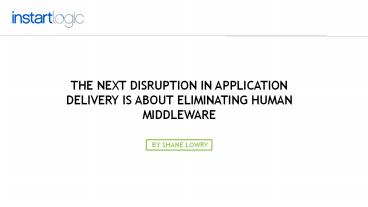Next Disruption in Application Delivery is Eliminating Human Middleware - PowerPoint PPT Presentation
Title:
Next Disruption in Application Delivery is Eliminating Human Middleware
Description:
Disruptions in application delivery are caused by: • growing content • diversity in device used • application shift into cloud The disruption is caused by human middleware who make decisions about all the necessary policies around caching, network, security, QoS and content. For web application delivery acceleration, visit: – PowerPoint PPT presentation
Number of Views:51
Title: Next Disruption in Application Delivery is Eliminating Human Middleware
1
THE NEXT DISRUPTION IN APPLICATION DELIVERY IS
ABOUT ELIMINATING HUMAN MIDDLEWARE
BY SHANE LOWRY
2
There are a number of disruptions going on that
are very interesting to those working in the
field of building web-based applications. Whether
you are an application developer or a site
operator, these disruptions are likely already
affecting your world. Content is getting
fatter. Consumers demand content that is
customized to who they are, where they are, who
they're connected to, their likes and dislikes.
At the same time, they want this content to be
fast and rich.
3
Device diversity is proliferating. People are
consuming more of this content on the go, on a
multitude of devices of different screen sizes
over some kind of wireless connection, whether is
be on a smartphone, tablet or laptop, over 3G,
4G, LTE or WiFi. I heard on NPR at the start of
2014 that online retailers were reporting that
for the first time over half of their holiday
transactions occurred on mobile
devices. Applications are moving to the
cloud. There is a move away from wholly-owned and
operated application infrastructure to
applications that are partially or completely
hosted in the cloud. Oftentimes, to deliver the
kind of personalization demanded, these apps need
to integrate services on the network to deliver
key parts of their capabilities. Mapping and
social network connections are two obvious
examples of this. All of this has a significant
effect on how your application gets delivered to
your consumers. The existing content delivery
infrastructure and approach starts to fragment.
The legacy approach to getting your content from
the datacenter to the client browser is a
composition of discrete appliances, networks,
middle-mile services, proxy servers and devices.
Control of this is in silos, embedded inside each
of these appliances and services, and requires a
great deal of human middleware to make decisions
about all the necessary policies around caching,
network, security, QoS and content. The problems
with this approach are obvious humans are way
too involved. We are prone to make mistakes. We
are slow. We sleep too much. There are too many
independent control points, which makes holistic
control difficult and error-prone. You need to
manually worry about diversity and variability
for example, of the spec of the end point or in
some cases, key problems are simply ignored, like
the latency and throughput of the access
network. It is next to impossible to deliver a
unified SLA on end user experience because it is
a patchwork of point solutions.
4
APPLICATION ARCHITECTURE OF THE FUTURE
5
What is necessary is to take this whole delivery
system from the first mile all the way through
to the client and reproduce it in software,
into a single, unified system. This must include
the endpoint, the last-mile and middle-mile
transport, caching and proxying, and key
first-mile ADC-type services. This allows us to
abstract the value that this delivery system
provides from the underlying hardware and
networking, and separate the data delivery from
control. The operator gets unified end-to-end
control and central configuration. The system can
be automated through a single set of APIs. We
now have control over both ends of the "pipe" and
can control and address the disruptions outlined
above, and in turn, do some disruptions of our
own. An end-to-end SLA is now possible.
End-to-end security and performance concerns can
now be realistically attacked. Taking control of
the last mile and attacking the bottlenecks there
is now possible. Dealing with deployment
diversity in the cloud is now within reach. And
in turn, those that deploy their web applications
across a system like this can have distinct
competitive advantages over those who do not
much greater control and adaptability, better
business agility, and better extensibility and
future-proofing. That looks to me like a
disruption in its own right. Over the coming
months we will focus on each of the points of
disruption outlined above and discuss in some
depth what they mean for web application
delivery. We're expecting an exciting series, so
subscribe to our RSS feed and engage in the
conversation.































